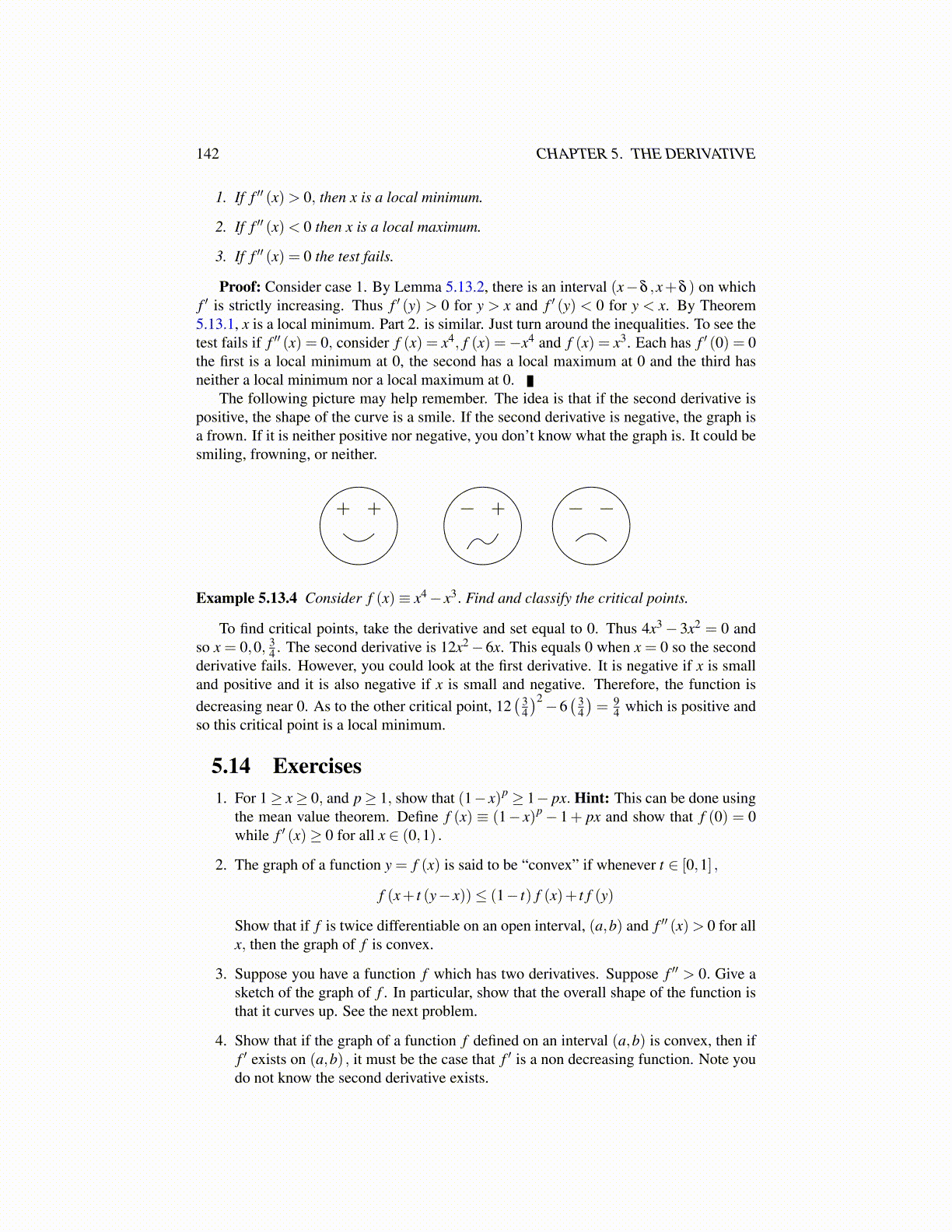
142 CHAPTER 5. THE DERIVATIVE
1. If f ′′ (x)> 0, then x is a local minimum.
2. If f ′′ (x)< 0 then x is a local maximum.
3. If f ′′ (x) = 0 the test fails.
Proof: Consider case 1. By Lemma 5.13.2, there is an interval (x−δ ,x+δ ) on whichf ′ is strictly increasing. Thus f ′ (y) > 0 for y > x and f ′ (y) < 0 for y < x. By Theorem5.13.1, x is a local minimum. Part 2. is similar. Just turn around the inequalities. To see thetest fails if f ′′ (x) = 0, consider f (x) = x4, f (x) =−x4 and f (x) = x3. Each has f ′ (0) = 0the first is a local minimum at 0, the second has a local maximum at 0 and the third hasneither a local minimum nor a local maximum at 0.
The following picture may help remember. The idea is that if the second derivative ispositive, the shape of the curve is a smile. If the second derivative is negative, the graph isa frown. If it is neither positive nor negative, you don’t know what the graph is. It could besmiling, frowning, or neither.
Example 5.13.4 Consider f (x)≡ x4 − x3. Find and classify the critical points.
To find critical points, take the derivative and set equal to 0. Thus 4x3 − 3x2 = 0 andso x = 0,0, 3
4 . The second derivative is 12x2 −6x. This equals 0 when x = 0 so the secondderivative fails. However, you could look at the first derivative. It is negative if x is smalland positive and it is also negative if x is small and negative. Therefore, the function isdecreasing near 0. As to the other critical point, 12
( 34
)2 −6( 3
4
)= 9
4 which is positive andso this critical point is a local minimum.
5.14 Exercises1. For 1 ≥ x ≥ 0, and p ≥ 1, show that (1− x)p ≥ 1− px. Hint: This can be done using
the mean value theorem. Define f (x) ≡ (1− x)p − 1+ px and show that f (0) = 0while f ′ (x)≥ 0 for all x ∈ (0,1) .
2. The graph of a function y = f (x) is said to be “convex” if whenever t ∈ [0,1] ,
f (x+ t (y− x))≤ (1− t) f (x)+ t f (y)
Show that if f is twice differentiable on an open interval, (a,b) and f ′′ (x)> 0 for allx, then the graph of f is convex.
3. Suppose you have a function f which has two derivatives. Suppose f ′′ > 0. Give asketch of the graph of f . In particular, show that the overall shape of the function isthat it curves up. See the next problem.
4. Show that if the graph of a function f defined on an interval (a,b) is convex, then iff ′ exists on (a,b) , it must be the case that f ′ is a non decreasing function. Note youdo not know the second derivative exists.